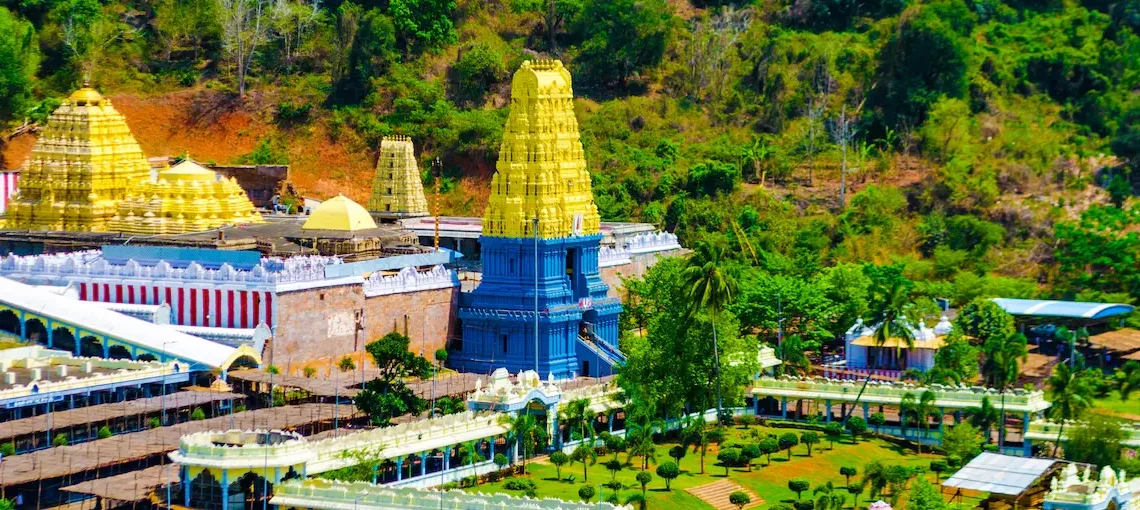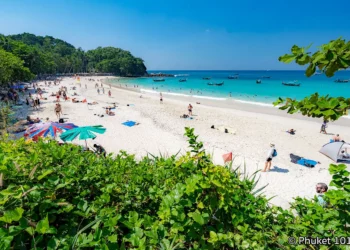The Simhachalam Temple in Visakhapatnam is a holy abode of Lord Narasimha, the fourth incarnation of Lord Vishnu as a lion-man form. Perched on Simhachalam Hill, 300 meters high with views of the Bay of Bengal, this 11th-century shrine covers about 3 acres. Known for its Chandanotsavam festival, the temple carries Visakhapatnam’s heritage and deep cultural past.
Legend of the Temple
An inetresting legend of Simhachalam Temple comes from the Narasimha Purana. Long ago, the demon King Hiranyakashipu created havoc for the gods and his son Prahlada, a Vishnu devotee. After being worshipped with utmost devotion by Prahlada, Lord Vishnu took the form of Narasimha, half-lion, half-man, and defeated the demon on this very hill in order to save him and the universe from the demon’s atrocities. The temple honors this victory, and people say praying here brings courage and protection. Another story tells of a Chola king in the 1000s who saw Narasimha in a dream, asking for a shrine. He built it, and Visakhapatnam grew strong, making Narasimha the hill’s protector.
History of the Simhachalam Temple
The temple’s roots reach back to the 11th century with the Cholas, though some say worship began earlier. A stone writing from 1030 CE nearby hints at a holy spot, but the temple we see started with Chola kings. Old records say priests kept its rituals alive. By the 13th century, Kalinga rulers added halls, as temple stones show. The Vijayanagara king Krishnadevaraya, in 1517, gave gold and fixed the gopuram, making it a big place for faith, old books tell.
In the 1600s, the temple was a lively spot, with fishermen, traders, and devotees keeping it strong, Visakhapatnam’s logs say. The Gajapati kings, from the 14th to 16th centuries, built paths up the hill, tying the temple to their lands. In 1800, British rule came, but the prayers held firm. After 1947, Andhra’s government took over, and the Endowments Board runs it now. Telugu songs by saints like Tallapaka Annamacharya, who sang for Vishnu, carried its name far, helping Andhra’s Bhakti ways grow.
Architecture of the Temple
The Simhachalam Temple blends Dravidian, Chalukya, and Kalinga styles, covering 3 acres. Its five-story gopuram, 30 meters tall, is full of carvings showing Narasimha’s battles, dancers, and elephant-like yalis, painted red and white. A stone door, carved with gods, leads to the sanctum, where the 11th-century Narasimha idol, covered in sandalwood paste, glows with lamps. A small shrine for Goddess Lakshmi, built in 1200, is near. The main holy room, fixed in 1500, has stone pillars with Vishnu Purana scenes and Kalinga signs.
The navaranga hall, with 16 pillars, shows Ramayana tales and Chola marks. A 12-foot Garuda statue, carved in 1400, stands outside, facing the deity. The courtyard has a holy tank, Gangadhara, for washing before prayers. Shrines for Ganesha and Surya are close. Wall carvings from the 1300s, cared for by the ASI, show Narasimha’s victory, making every corner a piece of the past. The temple’s hilltop spot, looking over Visakhapatnam’s sea, joins it to the city’s old days as a port, near the Krishna River.
Festivals and Rituals
The temple comes alive during festivals, especially Chandanotsavam in April or May, a grand day from Chola times. On this day, priests remove the sandalwood paste from Narasimha’s murti (idol), showing his true form, with devotees chanting mantras and prayers in devotion. Vaikuntha Ekadasi brings devotees in thousands, with oil lamps lighting the hill. Five daily rituals, from 6 AM to 8 PM (free to enter, ₹100 for fast darshan), see priests offering rice, flowers, and sweets, with the Vishnu mantra resonating throughout the hill.
Telugu bhajans and Bharatanatyam dances, sharing Narasimha’s tales, ring through the halls. Chandanotsavam’s special puja, with sandalwood scents, mixes faith and joy, as locals tell of Narasimha’s care and protection.
Getting to the Temple
Visakhapatnam Airport, 12 km away, has flights from Hyderabad (1 hour) or Delhi (2 hours). Taxis take 20 minutes to the temple. Visakhapatnam Railway Station, 8 km away, links to Chennai (12 hours), Kolkata (14 hours), and Bangalore (18 hours). Autos or taxis from the station take 15 minutes. Buses from Vijayawada (350 km, 7 hours) or Hyderabad (600 km, 12 hours) stop at Visakhapatnam Bus Stand, 10 km away. Local autos cost 20-50 rupees to the temple. No entry fee, but pujas may cost 100-500 rupees.
Practical Tips for Visiting
Andhra Pradesh gets hot, up to 40 degree Celsius, with rains from June to September. November to February is cooler, around 21 degree Celsius. Visit early in the morning in order to avoid crowds and heat. Shivaratri gets full, so book prayers early. Bring water and a hat for the hill paths. Autos in Visakhapatnam cost 20-40 rupees. Autos in Visakhapatnam cost 20-50 rupees.
Final Thoughts
The Simhachalam Temple is truly a spectacular abode of Narshimha reflecting Andhra’s sacred past and ancient heritage. This glorious temple invites and calls devotees from all around India and various parts of the world, making it a must-visit among Andhra’s shrines.











